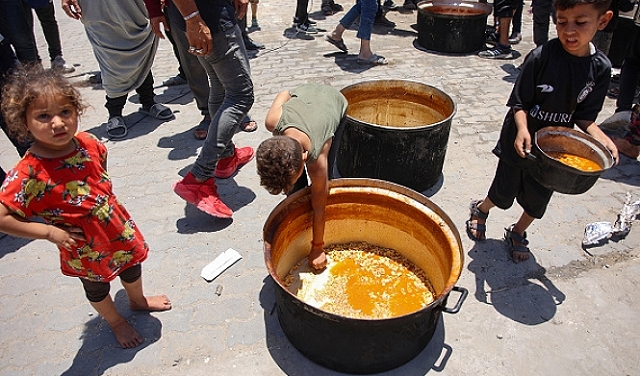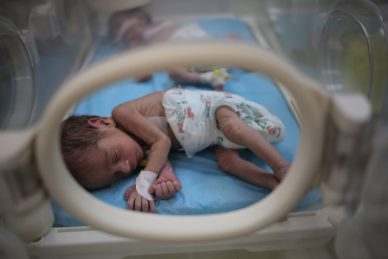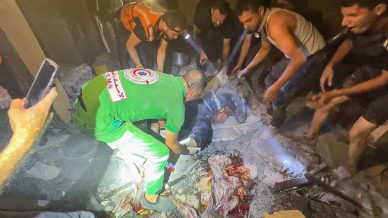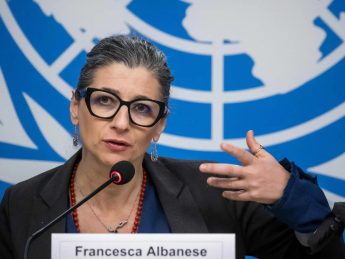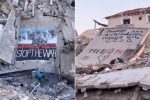GAZA, (PIC)
“I felt hungry, so I got up and took a piece of plain bread, along with a cup of tea without sugar,” said the young man, Yusuf Thabet, describing the miserable conditions in the southern regions of Gaza, where famine has become a harsh reality.
Thabet, a 30-year-old father of four, gestures toward his kitchen, confirming to our reporter that there is nothing to eat except for bread that has been infested with “worms” and “weevils.” He states, “Even the infested and spoiled flour is extremely expensive.”
For the past few weeks, famine has taken its toll on the bodies of Gazans in the south, just as it has in the north, becoming a focal point of the war. It has turned into a topic of media and political discussion, and the scene has grown darker and more despairing. Obtaining a loaf of bread has become a daily battle for citizens in Gaza, a struggle for survival amidst a painful and harsh reality.
Palestinians in northern Gaza have been suffering from hunger and death for months, and the fate of residents in the south, including the displaced, is similar, with hunger being a daily experience and bombings and massacres occurring everywhere.
This starvation coincides with a decision made by the Israeli Foreign Minister to cancel the operational agreement with the United Nations Relief and Works Agency for Palestine Refugees in the Near East (UNRWA), which has been in effect since 1967. This decision follows a resolution passed by the Israeli Knesset to terminate the agency’s activities, which are essential for distributing aid in Gaza, a region under the threat of genocide.
Israeli media reports describe the nature of the blockade on Gaza, indicating that there are currently three concentric rings of siege applied to the Gaza Strip, each subject to various restrictions. First, the entire area is under siege, with no one allowed to enter or exit without a decision from the occupying army.
A second blockade is imposed on the entirety of northern Gaza, extending from the Wadi Gaza area to the north, including the city of Gaza.
The occupying army enforced a third and an even stricter blockade on northern Gaza at the beginning of last month, particularly surrounding the cities of Jabalia, Beit Hanoun, and Beit Lahia. One UN official described this situation as a “siege within a siege within a siege.”
We go to sleep hungry
In her tattered tent set up on the beach of Deir Al-Balah in central Gaza, the widow Um Hussein al-Asouli, whose home was destroyed during the large-scale attack on Khan Yunis, told the PIC reporter, “I swear, I’m confused about what to feed the orphans. Bread is missing, vegetables and fruits are missing. What can we do? We are starving and go to sleep without food.”
With tears of sorrow and pain in her eyes, Um Hussein continued, “We eat canned food daily—beans and peas—all of which contain preservatives and may have spoiled due to prolonged storage in the markets and at the crossings.”
Um Hussein appeals to the world and its free people for intervention to save the Palestinian people in Gaza from the quagmire of famine and genocide, as “Israel kills us with rockets and bombs day and night, as well as through hunger and thirst.”
Our reporter confirmed that the prices of canned goods have been steadily rising, with a single can costing about 10 shekels (the dollar = 3.75 shekels). Palestinians cannot afford to buy them due to the erosion of purchasing power, lack of liquidity, and loss of jobs.
Last month, the Israeli occupation army closed the Karam Abu Salem crossing and tightened restrictions, halting the entry of humanitarian and commercial trucks, which has had severe repercussions on the life of Gazans, leading to empty markets and skyrocketing prices.
According to our correspondent, a 25-kilogram bag of flour costs 50 US dollars, and a kilogram of meat also costs 50 dollars, while a kilogram of eggplant costs 4 dollars. Tomatoes, eggs, and red and white meats are virtually nonexistent, with local sources estimating that around 90% of essential goods are missing from the markets, and what remains is extremely expensive.
Deprived of everything
Citizen Mahmoud al-Haddad, with tears in his eyes, told our reporter that his children eat only bread and a little thyme daily. He added, “We are deprived of food, fruits, vegetables, sweets, and juices—deprived of everything.”
His son, Osama, sits beside him, calling for his mother to make him something to eat, but he responds, “There’s nothing but a little bread with a sprinkle of spice or thyme.”
The weapon of hunger
In the northern part of the Strip, the situation appears even harsher and more dire, where there is little to eat, and if available, it consists of a few cans and bread at exorbitant prices.
Citizen Muhammad Muqdad, who lives in his destroyed home in the Shati Camp west of Gaza City, told our reporter: “We have lost weight; we have been eating only a few canned goods for many months now, and we can barely stand.”
Israel is using hunger in northern Gaza as part of a plan by military generals to empty the area of its residents and declare it a closed military zone. Media reports indicate that trucks loaded with aid and vegetables are allowed to enter in very limited quantities, which does not provide any real relief to the population.
Muqdad said that for many months, they have not had chicken, meat, or fruits. “We can barely get flour, which keeps us from dying.”
The UN Office for the Coordination of Humanitarian Affairs (OCHA) states that the delivery of humanitarian aid to the Strip faces significant obstacles, especially in reaching the northern regions. According to OCHA, “There is an urgent need to open safe and sustainable corridors to reach northern Gaza and other areas in the Strip,” emphasizing that “limited and unreliable crossings hinder humanitarian relief operations and render them ineffective.”
In OCHA’s latest update, it was reported that since October 7, 2024, the World Food Program, like other partners, has lost access to the seven nutrition sites that were active in northern Gaza between October 1 and 7, and no emergency food rations based on fats have been distributed.
As of October 28, only 12 out of 19 bakeries supported by the World Food Program are operating in the Strip—four in Gaza City, seven in Deir al-Balah, and one in Khan Yunis. Two bakeries in northern Gaza and five in Rafah remain closed due to the war.
In a recent report, UNRWA said, “More than 1.8 million people across the Strip are suffering from high levels of acute food insecurity, classified as Phase 3 of the crisis classification or higher,” noting that “acute malnutrition is ten times higher than it was before the war.”
Reduction of aid
Recently, the Israeli occupation has significantly reduced the volume of aid entering the Strip, leading to visible signs of famine in the southern and central regions, similar to what is occurring in Gaza City and northern Gaza.
The Israeli occupation army controls the movement of exports and imports to the Strip through its control of the border crossings, blocking the entry of goods and food supplies and using starvation as a political tool to pressure Palestinian resistance regarding negotiations over the exchange of Israeli prisoners in Gaza.
According to the Government Media Office in Gaza, the Strip used to receive daily between 500 and 800 trucks through various crossings, carrying food supplies, construction materials, fuel, cooking gas, medicines, and medical supplies. Currently, the number of trucks allowed to enter is merely in the dozens.
According to a recent United Nations report, the threat of famine in Gaza will continue throughout the winter unless fighting stops and more humanitarian aid reaches families. This assessment of food security in the region predicts that 1.95 million people in Gaza (91% of the population) will face severe food insecurity.
The report pointed out that the prolonged war in Gaza, lasting over a year, has led to the destruction of livelihoods, reduced food production, and significantly restricted commercial and humanitarian supply lines.

